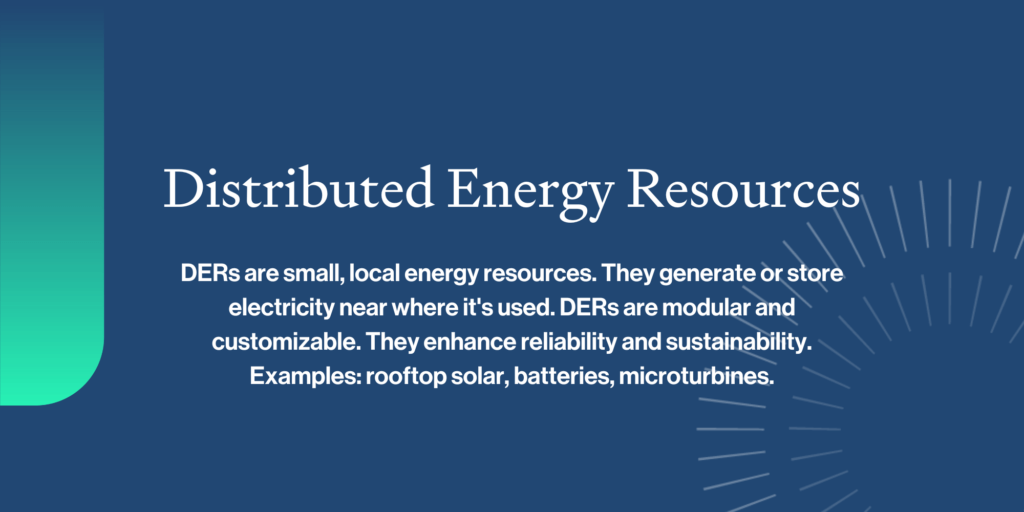This blog post is the third in an eight-part series on navigating the transition to sustainable energy based on company-wide emails crafted by Fred Lee, PCI founder and CEO, and Bryan Kelly, VP of Product Management. This series will help you understand the integration of renewable resources into the electricity grid and equip you with insights and strategies to navigate the changing energy landscape successfully.
The energy landscape is undergoing a remarkable transformation as distributed energy resources (DERs) take center stage. These small-scale, modular technologies located at or near customer sites are fundamentally changing how electricity is generated, delivered, and managed. DERs such as rooftop solar, microturbines, and battery storage introduce both opportunities and challenges for utilities as their adoption rapidly accelerates.
In this blog post, we explore the intricacies and impacts of one of the most potentially transformative DER advancements: aggregation programs that allow DERs to participate in wholesale energy markets. With new FERC rules mandating DER aggregation, the utility industry is navigating uncharted territory. Optimizing aggregated resources requires overcoming daunting analytics challenges. And new business models are emerging that could either increase or threaten utility revenue streams.
By delving into real-world DER aggregation initiatives, we’ll uncover invaluable insights and strategies so your utility can capitalize on the monumental changes underway. Gaining perspectives from the front lines will equip you to optimize the value of DERs, boost grid reliability, engage customers, and carve a path toward a more decentralized, democratized electricity system. The rise of DERs brings a complex set of obstacles and opportunities — let’s explore them together
What is a Distributed Energy Resource?

First, let’s ensure we have the same definition of Distributed Energy Resources (DERs). They’re small-scale power generation or storage technologies that are located close to where electricity is consumed. DER systems are usually sized below 10 megawatts (MW) and can be installed on-site to match a facility’s energy needs. This distinguishes them from traditional centralized power plants, which generate large amounts of electricity that is sent long distances over transmission lines to end users.
DERs encompass a variety of modular devices, including rooftop solar panels, microturbines, energy storage batteries, electric vehicles, and more. Their modular nature and proximity to loads enables DERs to provide energy where it’s needed and enhance local power reliability and resiliency. The rapid expansion of DERs is transforming how electricity is generated, managed, and delivered in a more decentralized manner.
Distributed Energy Resources examples
Many technologies fall under the umbrella of distributed energy resources. Some common examples include:
- Rooftop solar photovoltaic (PV) systems that convert sunlight into electricity. PV panels can range from small-scale residential systems to large-scale commercial or industrial arrays.
- Energy storage batteries that store energy for later use. Batteries provide backup power and help smooth fluctuations in renewable generation.
- Combined heat and power (CHP) systems that generate electricity while capturing heat for additional applications. CHP improves overall fuel efficiency.
- Microturbines and reciprocating engines that produce on-site power from fuels like natural gas, biogas, hydrogen, and biofuels.
- Fuel cells that electrochemically convert hydrogen into electricity with minimal emissions.
- Electric vehicles (EVs) capable of storing energy and transferring it back to the grid when needed.
Understanding DER aggregation programs
Now that you have a good understanding of DERs, let’s move on to DER aggregation programs. With the passing of FERC Order 2222 in 2020, independent system operators and regional transmission organizations (ISOs/RTOs) are now mandated to allow DER participation in wholesale energy markets. This ruling enables any resource, regardless of type or size, to provide energy, capacity, and ancillary services.
To qualify under the 100 kilowatt (kW) minimum capacity requirement, DERs can be grouped together into aggregations. DER aggregates are modeled as single grid-connected assets, with physical characteristics, contractual terms, and operational constraints binding their coordination.
Optimizing DER aggregates presents challenges
Managing DER aggregates introduces complex new optimization challenges. Determining the ideal dispatch of each individual resource requires weighing factors like weather forecasts, generation output, energy prices, and contractual limitations.
Sophisticated analytics are vital for modeling the intricate decision space and maximizing the value of DER aggregations. As more distributed resources come online, scaling optimization capabilities becomes paramount.
Impacts across the utility organization
Incorporating DER aggregates impacts utilities at multiple levels:
- Customer engagement: Marketing, education, and incentives are key to enroll customers with DER assets into aggregation programs.
- Distribution grid: Bidirectional metering and communication systems are needed to connect DERs. Modeling and data management prevent double-counting of grid services.
- Wholesale marketing: Advanced optimization unlocks the value of DER flexibility. ISO/RTO market participation requires aggregation and disaggregation of dispatch signals.
- Technology: Smooth coordination between customer-facing, distribution, and bulk power systems is essential. Cybersecurity also becomes more critical.
New business models emerge
DER aggregation propels new business models with benefits like:
- Increased grid reliability from controllable resources
- Revenue growth by leveraging customer DER investments
- Reduced peak demand charges
- Access to new revenue streams through wholesale market participation
However, these models may also negatively impact utility revenue streams. Careful strategy development and continuous innovation are key to realizing the potential of DERs.
The path forward
At PCI, we’re committed to providing utilities the analytics needed to optimize DER aggregation programs. By enhancing scalability, honing optimization techniques, and enabling seamless coordination between systems, our platform paves the path to capitalize on the promise of distributed energy.
To learn more, contact our team for a personalized demo showing how our solutions can empower your DER strategy.







